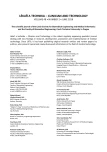Response by an automated inspired oxygen control system to hypoxemic episodes: assessment of damping
Autoři:
Thomas E. Bachman; Jakub Ráfl
Působiště autorů:
Department of Biomedical Technology, Faculty of Biomedical Engineering, Czech Technical University in Prague, Kladno, Czech Republic
Vyšlo v časopise:
Lékař a technika - Clinician and Technology No. 2, 2018, 48, 41-45
Kategorie:
Original research
Souhrn
Manual titration of inspired oxygen necessary to adequately respond to respiratory fluctuations of the neonate is a challenging task. Furthermore, exposure to high and low levels of oxygen saturations are associated with significant morbidity and mortality. Ventilators that automatically control inspired oxygen based on pulse oximeter signals are becoming available and seem to be safe and effective when compared to manual control. However, the potential to overshoot in response to a hypoxemic episode, thus causing excess hyperoxemia, has not been carefully studied. We evaluated the response of one automated FiO2-SpO2 control system to 7,667 desaturations in 21 infants over 113 days. We found that the sustained response to desaturations resulted primarily in achievement of normoxemia with balance between high and low saturations. We concluded that this closed loop control system was adequately damped. We suggest that this kind of analysis might be helpful is refining control algorithms.
Keywords:
oxygen control, physiological closed loop controller, neonatal
Zdroje
- Hagadorn, J. I., Sink, D. W., Buus-Frank, M. E., et al.: Alarm safety and oxygen saturation targets in the Vermont Oxford Network iNICQ 2015 Collaborative. J Perinatol, 2017; vol. 37, no. 3, pp. 270–276.
- Cummings, J. J., Polin, R. A., Committee on Fetus and Newborn: Oxygen targeting in extremely low birth weight infants. Pediatrics, 2016, vol. 138, no. 2, e20161576.
- Claure, N., Bancalari, E.: Closed–loop control of inspired oxygen in preterm infants. Sem Fetal & Neonatal Med, 2015, vol. 20, no. 3, 198–204.
- Claure, N., Bancalari, E., D’Gard, C., et al.: Multicenter crossover study of automated control of inspired oxygen in ventilated preterm infants. Pediatrics, 2011, vol. 127, no. 1, pp. e76–83.
- Lal, M., Tin, W., Sinha, S.: Automated control of inspired oxygen in ventilated preterm infants: crossover physiological study. Acta Paediatr, 2015, vol. 104, no. 11, pp. 1084–1089.
- Waitz, M., Schmid, M., Fuchs, H., et al.: Effects of automated adjustment of the inspired oxygen on fluctuations of arterial and regional cerebral tissue oxygenation in preterm infants with frequent desaturations. J Pediatr, 2015, vol. 166, no. 2, pp. 240–244.
- Van Kaam, A. H., Hummler, H., Wilinska, M., et al.: Automated versus manual oxygen control with different saturation targets and modes of respiratory support in preterm infants. J Pediatr, 2015, vol. 167, no. 3, pp. 545–550.
- IEC 60601-1-10: Medical electrical equipment – Part 1-10: General requirements for basic safety and essential performance – Collateral standard: Requirements for the development of physiologic closed-loop controllers. The International Electrotechnical Commission, 2007.
- Sola, A.: Oxygen saturation in the newborn and the importance of avoiding hyperoxia-induced damage. NeoReviews, 2015, vol. 16, no. 7, e395.
- Warakomska, M., Bachman, T. E., Wilinska, M.: Randomized evaluation of two SpO2 alarm strategies during automated FiO2 control in the NICU. PAS 2018.
- Fathabadi, O. S., Gale, T. J., Lim, K., et al.: Characterisation of the oxygenation response to inspired oxygen adjustments in preterm infants. Neonatology, 2016, vol. 109, pp. 37–43.
- Van Zanten, H. A., Tan, R. N., Thio, M., et al.: The risk for hyperoxaemia after apnoea, bradycardia and hypoxaemia in preterm infants. Arch Dis Child Neonatal Ed, 2014, vol. 99, no. 4, pp. F269–273.
- Van den Heuvel, M. E., van Zanten, H. A., Bachman T. E., et al.: Optimal target range of closed-loop inspired oxygen support in preterm infants: a randomized controlled study. J Pediatr, 2018, vol. 197, pp. 36–41.
- Wilinska, M., Bachman, T. E., Swietlinski, J., et al.: Automated FiO2-SpO2 control system in neonates requiring respiratory support: a comparison of a standard to a narrow SpO2 control range. BMC Pediatr, 2014, vol. 14, 130.
- Bachman, T. E., Newth, C. J. L., Iyer, N. P., et al.: Hypoxemic and hyperoxemic likelihood in pulse oximetry ranges: NICU observational study. Arch Dis Child Neonatal Ed, 2018, Jun 20. pii: fetalneonatal-2017-314448. doi: 10.1136/archdischild-2017-314448. [Epub ahead of print].
Štítky
BiomedicínaČlánok vyšiel v časopise
Lékař a technika

2018 Číslo 2
Najčítanejšie v tomto čísle
- Application of sibgle wireless holter to simultaneous EMG, MMG and eim measurement of human muscles activity
- Response by an automated inspired oxygen control system to hypoxemic episodes: assessment of damping
- Workflow for bioprinting of cell-ladem bioink
- Machine learning using speech utterances for parkinson disease detection
